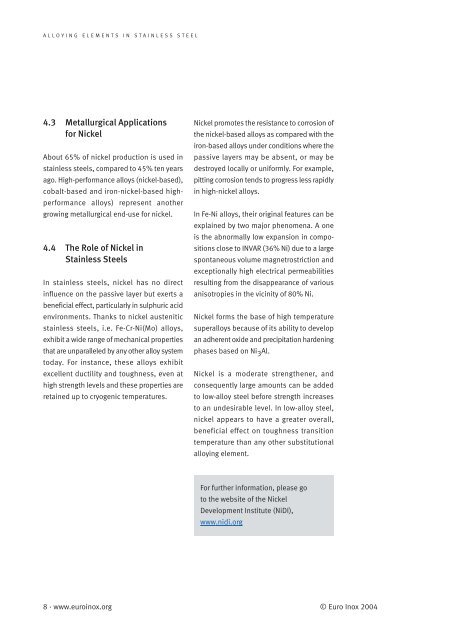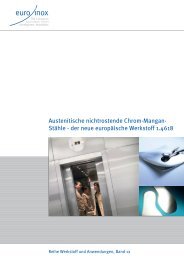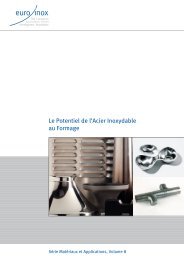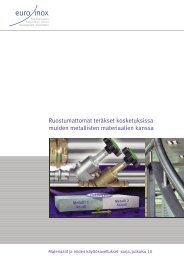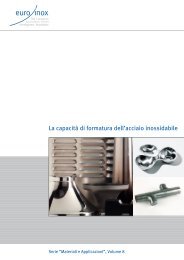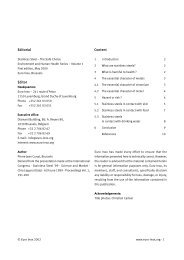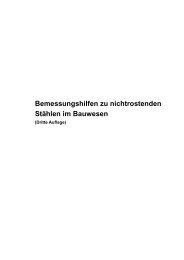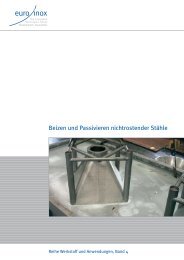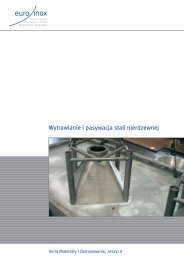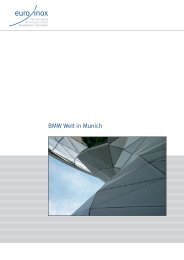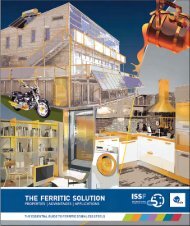Alloying Elements in Stainless Steel and Other Chromium - Euro Inox
Alloying Elements in Stainless Steel and Other Chromium - Euro Inox
Alloying Elements in Stainless Steel and Other Chromium - Euro Inox
You also want an ePaper? Increase the reach of your titles
YUMPU automatically turns print PDFs into web optimized ePapers that Google loves.
ALLOYING ELEMENTS IN STAINLESS STEEL<br />
4.3 Metallurgical Applications<br />
for Nickel<br />
About 65% of nickel production is used <strong>in</strong><br />
sta<strong>in</strong>less steels, compared to 45% ten years<br />
ago. High-performance alloys (nickel-based),<br />
cobalt-based <strong>and</strong> iron-nickel-based highperformance<br />
alloys) represent another<br />
grow<strong>in</strong>g metallurgical end-use for nickel.<br />
4.4 The Role of Nickel <strong>in</strong><br />
Sta<strong>in</strong>less <strong>Steel</strong>s<br />
In sta<strong>in</strong>less steels, nickel has no direct<br />
<strong>in</strong>fluence on the passive layer but exerts a<br />
beneficial effect, particularly <strong>in</strong> sulphuric acid<br />
environments. Thanks to nickel austenitic<br />
sta<strong>in</strong>less steels, i.e. Fe-Cr-Ni(Mo) alloys,<br />
exhibit a wide range of mechanical properties<br />
that are unparalleled by any other alloy system<br />
today. For <strong>in</strong>stance, these alloys exhibit<br />
excellent ductility <strong>and</strong> toughness, even at<br />
high strength levels <strong>and</strong> these properties are<br />
reta<strong>in</strong>ed up to cryogenic temperatures.<br />
Nickel promotes the resistance to corrosion of<br />
the nickel-based alloys as compared with the<br />
iron-based alloys under conditions where the<br />
passive layers may be absent, or may be<br />
destroyed locally or uniformly. For example,<br />
pitt<strong>in</strong>g corrosion tends to progress less rapidly<br />
<strong>in</strong> high-nickel alloys.<br />
In Fe-Ni alloys, their orig<strong>in</strong>al features can be<br />
expla<strong>in</strong>ed by two major phenomena. A one<br />
is the abnormally low expansion <strong>in</strong> compositions<br />
close to INVAR (36% Ni) due to a large<br />
spontaneous volume magnetrostriction <strong>and</strong><br />
exceptionally high electrical permeabilities<br />
result<strong>in</strong>g from the disappearance of various<br />
anisotropies <strong>in</strong> the vic<strong>in</strong>ity of 80% Ni.<br />
Nickel forms the base of high temperature<br />
superalloys because of its ability to develop<br />
an adherent oxide <strong>and</strong> precipitation harden<strong>in</strong>g<br />
phases based on Ni3Al. Nickel is a moderate strengthener, <strong>and</strong><br />
consequently large amounts can be added<br />
to low-alloy steel before strength <strong>in</strong>creases<br />
to an undesirable level. In low-alloy steel,<br />
nickel appears to have a greater overall,<br />
beneficial effect on toughness transition<br />
temperature than any other substitutional<br />
alloy<strong>in</strong>g element.<br />
For further <strong>in</strong>formation, please go<br />
to the website of the Nickel<br />
Development Institute (NiDI),<br />
www.nidi.org<br />
8 · www.euro<strong>in</strong>ox.org © <strong>Euro</strong> <strong>Inox</strong> 2004


